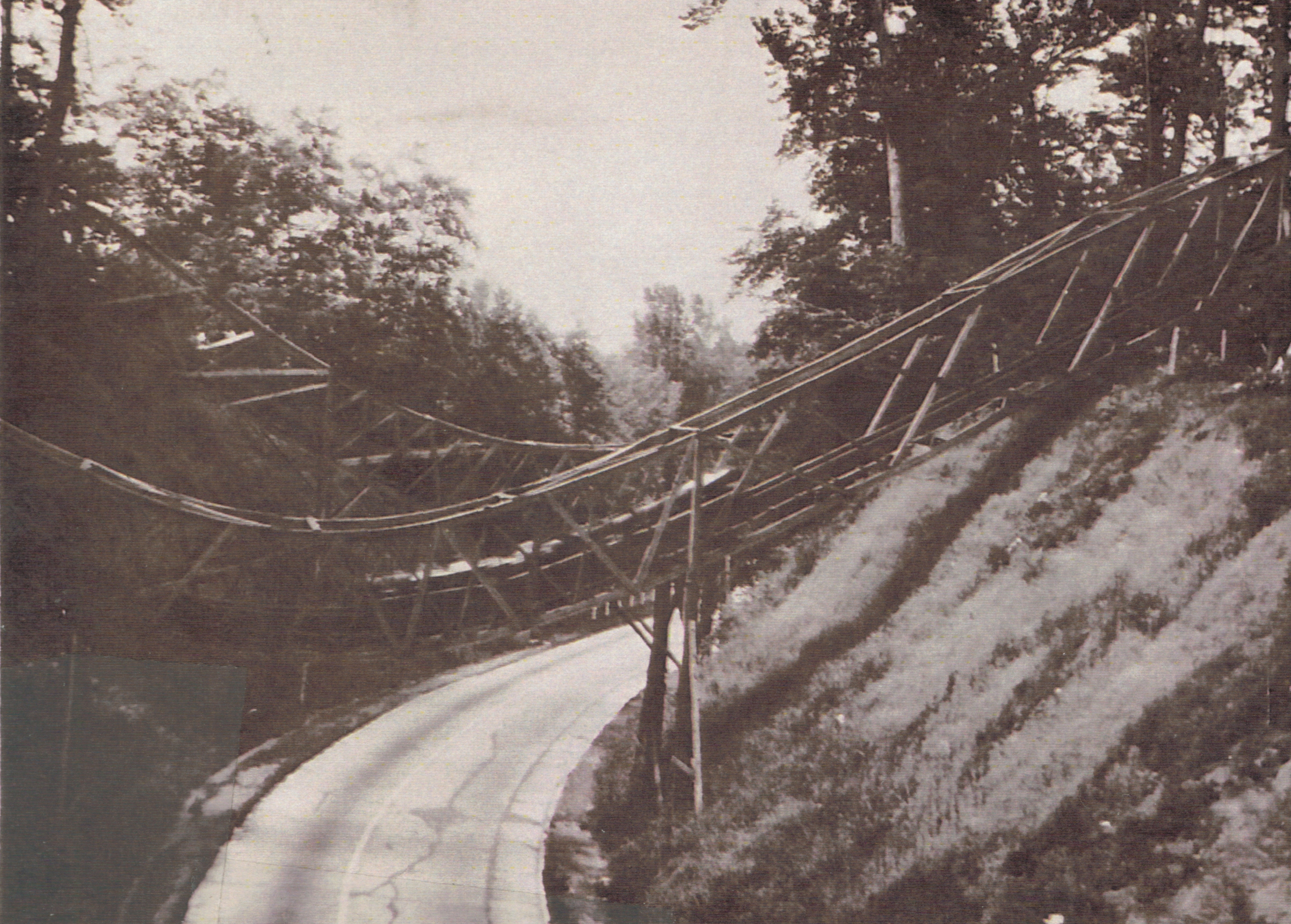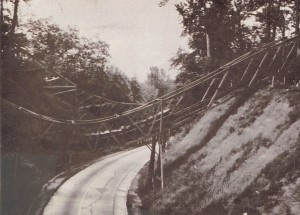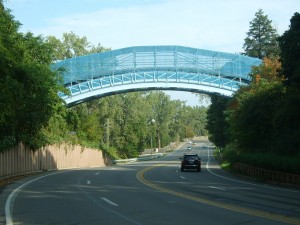The Story of Waldameer’s First Ravine Flyer Roller Coaster

Waldameer’s First Ravine Flyer (Ravine Flyer I)
When I was a kid, my mother told me that long, long ago, a roller coaster used to pass right over Peninsula Drive, in our hometown of Erie, PA. She said that a young man died after he fell out of the Waldameer Park roller coaster, onto the street, and after that, the roller coaster was dismantled.
It seemed strange that an amusement-park ride would be built right over a public road, so I always thought my mother’s story was an urban legend. But in 2008, Waldameer introduced the Ravine Flyer II, and it built a portion of the track over Peninsula Drive. I still doubted that anyone actually fell out of Ravine Flyer I, and died.
I was wrong.
In 2014, while I was researching the life of W.E. Dimorier, I came across some microfilmed newspaper articles about the tragedy. I captured them with the intent of sharing them at some point. So, two years later, here we go.
Initial Reports Say Young Man Jumped
On Monday, August 8, 1938, the Erie Dispatch-Herald reported:
“Youth, 19, Leaps to Death from Ravine Flyer.”
The initial story reported that the previous evening, Clarence Sersch of Aspinwall, PA, near Pittsburgh, had suffered a skull fracture after he became “fear-stricken” and jumped from the coaster, 18 feet to the street below, while his sister, Mary, looked on. He died at St. Vincent Hospital several hours later, and Mary was in “hysterical condition,” under the care of a doctor in the home of Captain and Mrs. Paul Barclay.
Mary Sersch was not the only person who witnessed the tragedy. The newspaper listed the names and addresses of the eight other individuals present in the coaster car. They were: Caroline Larson and her brother, Jack, 1154 W. 30th St.; and Mary Cray, 2118 Liberty St., of Erie. The other witnesses were Marian Coburn, 143 Camp May Ave., Pittsburgh; Jessie Ryan, 1517 Rockland Ave, Beechville, Pittsburgh; Eugene Jenson, Celeron, NY; Charles Tremaine, Jamestown, NY; and Betty Smith, Pittsburgh.

Dip over Peninsula Drive
Photo Provided by Waldameer
Witnesses told the park manager, Alex Moeller, that, “the car suddenly lost its speed as it reached the bottom of the dip and began to swing back and forth until it came to a stop.” They said that’s when Clarence Sersch, the son of John G. Sersch, a Pennsylvania Railroad police officer, jumped.
Below the track, traffic was heavy on Peninsula Drive, and Raymond Ropp, of 217 W. 17th Street, told police he was heading south, when he noticed a body fall 100 feet in front of his car. Several other cars almost hit Sersch.
Not a Jump From the Coaster, But a Fall
The next day, the newspaper reported that Sersch, a 200-pound, Temple University football player, had apparently fallen by accident from the coaster track. The investigators, Corporal Charles Sorok and District Attorney M. E. Graham, doubted the story that Sersch had intended to jump. The coroner, W.G. Stroble, said an inquest would be held the following week. Speculation was that the young man had stepped out of the car on the side of the track that had no catwalk.
Another newspaper article remarked that the coaster death was just one of a long list of jinxes that season. Rainbow Gardens, the beautiful ballroom, had burned to the ground. The “Crazy House” had also been destroyed by fire. Someone had recently spread a box full of carpet tacks on the children’s auto track, puncturing the tires on one of the cars. Pickpockets were also in operation. Some of the employees were starting to refer to the “1938 curse.”
Inquest Ordered, Ride Shut Down
Three days after the tragedy, District Attorney Graham ordered the Ravine Flyer closed, pending the investigation. Park Manager Moeller supported the order. He said that the coaster, which had been constructed in 1921, hadn’t had any riders since the accident, and it might be torn down. The park had dismantled a similar ride, the “Figure of Eight,” the previous spring as a safety measure.
According to Graham’s initial investigation, the “dip,” where the car had stalled, showed splintering on the runway, and the bottom of the car appeared damaged. He speculated that the recent heavy rain had caused the wood to expand, “jamming the sides of the car and retarding its progress along the track.” Moeller said that the coaster had been inspected as recently as two days before the incident, and regularly before that.
Questioning of the witnesses indicated that Sersch had not been in a panic when he fell, as had been originally reported. The district attorney stated that he was satisfied the fall was an accident. A newspaper article reported that Mae Sersch told the district attorney her brother fell when he “saved her from toppling over the side of the car.”
On Friday, August 19, 1938, the coroner’s inquest was held. The Erie Dispatch-Herald reported Mae Sersch’s testimony that her brother stood up as the car was stopping. “He was looking backward to see whether another car might be coming along—and fell over the side. He did not jump.” The Erie Daily Times reported that the young woman said as her brother stood, the car appeared to jerk, and then he fell.
Harvey Petys, park superintendent, and Lawrence Jones, ride operator, both testified that the wheel on the right rear of the car had frozen, and this slowed the car down. Both men said that the entire runway had been inspected just six hours prior to the accident. Photographic evidence showed that woodwork was ripped along the rails, indicating that a wheel, or a bolt on the wheel, had dragged. The district attorney pointed out evidence of rotted planks as well, but both park employees said they were unaware of such defects.
The Coroner’s Jury Decides
After hearing the testimony, the coroner’s jury determined that the defective structure was responsible for Clarence Sersch’s death. They did not determine whether the young man jumped, or fell, from the ride. The ride was ordered condemned. Soon after, it was torn down.
Waldameer Legacy Continues
The idea of a roller coaster, spanning Peninsula Drive, was just folklore until 2008, when Waldameer installed the Ravine Flyer II. The wooden coaster is a favorite among thrill seekers and the track arches above the road rather than dipping, as its predecessor did. Also, there’s no cause to worry about a repeat of the 1938 fall, because an enclosure wraps the portion of the track above the road.

Photo Credit: Mary Bliss, flickr
https://creativecommons.org/licenses/by/2.0/
So, there you have it—the story of the original Ravine Flyer. Today, Waldameer Park remains a well-loved Erie tradition. In addition to its attraction as an amusement park, Waldameer also features a water park with numerous slides, a kiddie area, and a massive wave pool.
There aren’t many people left who remember the 1938 tragedy. Instead, Erie natives, transplants, and tourists, of all ages, treasure individual memories of various Waldameer eras. It would be difficult to find an Erie resident who has not visited this park, and families today continue to make memories there, and likely will, far into the future.
Newspaper Articles Consulted:
“Youth, 19, Leaps to Death From Ravine Flyer,” Erie Dispatch-Herald, 8-8-1938.
“Await Inquest to Decide Cause of ‘Flier’ Death, Erie Dispatch-Herald, 8-9-1938.
“Flyer Rid at Waldameer Shut Down,” Erie Dispatch-Herald, 8-11-1938.
“Youth’s Death to Be Probed.” Erie Dispatch-Herald, 8-15-1938.
“Defective Flyer is Blamed for Death of Youth.” Erie Dispatch-Herald, 8-19-1938.
“Ravine Flyer is Condemned in Probe of Youth’s Death.” Erie Daily Times, 8-19-1938.
Ann Silverthorn writes about a wide variety of topics in numerous genres. She recently completed a biography of William E. Dimorier (1871-1951), a forgotten poet and educator, who dedicated his life to service and leadership and is pursuing publication. Several new projects are underway.
Facebook: www.facebook.com/AnnSilverthorn
Twitter: @annsilverthorn
Instagram: ann_silverthorn




Very interesting piece. Thanks for researching!
Do you know if the new coaster built over the same easement as the previous one?
I’m not sure, Chuck. I just added two photos provided by Waldameer. If Peninsula Drive hasn’t changed its route much since 1938, it looks like the new one might be pretty close to where the old one crossed the road.
It’s in the Same spot the dip just doesn’t go down and the replace the track like every few years
Very interesting! Thank you for doing the research!
I heard from my dad that it use to go over the lake and someone fell off there. That has to be the same coaster. Is it?
Nancy
I,too remember my mother telling this story.How strange the news coverage of bygone years that they would list the names and addresses of everybody in the car.Could that policy have encouraged vandals to do the other damage? Or was vandalism an excuse to dispose (too late for the youngman)of unwanted rides.Any oldie know how many funhouses they had at a time?I remember one closed by about 1950.Would they shutter a ten yr old building?
Yes my Mom was there that day waiting for the next ride on the coaster.She said they all witnessed as the coaster slowed down the guy stood up and it jerked and the guy was flung over the side.
Engagingly written, well-researched, easy to follow – my thanks for the most extensive article I have ever seen on this story! My parents were both just little kids of when this tragedy occurred, but I had heard about it many times from them and other family members. No one was ever able to supply many details, however. Nice job – thank you!! 🙂
Is there any info on 2 girls who were thrown out of flying coaster because door ame open while riding this ride? Back in 60s
Wow, good question, Nancy. Might be in the digital collection of Erie newspapers available online through the Erie County Library.
Another great piece, Ann!
Thank you so much!
Wondering if you know anything about the lagoon that use to be between Waldameer Park and Waldameer Beach?
No, sorry Lori!